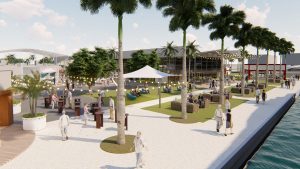Meeting Mentor Magazine
Outdoor Events Trend Likely to Outlast the Pandemic
While the burgeoning health and wellness trend had already drawn many meeting and event organizers to start taking more advantage of the outdoor spaces offered by their host venues, that trend caught fire during 2020 when many indoor spaces were off limits due to COVID-19 restrictions.
However, says Scott LaMont, CEO of award-winning landscape architecture firm EDSA, don’t expect that increased use of outdoor space for events to subside as indoor meeting restrictions begin to ease. LaMont has been working with developers, pivoting projects in real time to adjust to the changing needs of an increasingly outdoors-friendly new normal.
“Everything that has happened over the past year has raised awareness of the benefits of taking meetings outside,” he says. “It’s given us all a fresh perspective on how outdoor areas can be used. Venues are beginning to see that they can capitalize their outdoor spaces to provide an environment where people can feel safe and comfortable.
“As landscape architects, this gives us the opportunity to take the next step and program those spaces to be both functional and comfortable meeting environments.” EDSA has partnered with major event operators to plan outdoor events that are created with the guest experience in mind.

Scott LaMont, CEO of landscape architecture firm EDSA
“We work to interject the design eye into the event mentality and bring in an experiential point of view. It’s not just about setting up a beautiful event with great guest traffic flow, but also thinking about the operational side — loading and unloading, and where the generators are going to be — to maximize efficiencies.”
MeetingMentor recently caught up with LaMont to find out more about the future of outdoor events.
What types of business events are best suited for outdoor settings, and which tend to be more challenging?
I think we’ll see a hybrid moving forward, with some indoor meetings having outdoor breakouts and vice versa.
As to the types of groups, it really depends on the number of people. When you have a large group in an outdoor setting, you’re usually in a tent, which can almost begin to feel like an indoor setting. Smaller and medium-sized groups have more flexibility to really engage with the outdoor environment and create engaging experiences.
That said, where five years ago you would expect a group to just move ballroom to ballroom in a convention center, now you’re more likely to see vendors and others hosting interactive events, tours and outdoor demonstrations.
What are some of the design and logistical challenges in moving a business event from the ballroom to the outdoor spaces?
One of the challenges is understanding how to integrate technology into the outdoor environment, especially for events that will have both in-person and virtual attendees. Many of the hotel projects we’re working on are planning outdoor infrastructure with the understanding in mind that we need to have power, and Wi-Fi, in place. That’s no longer a nice-to-have — it’s a necessity.
We also have to consider that whatever we construct has to be temporary. We’re building it in an environment for a specific set of uses at a specific time, so everything has to be designed to be flexible and highly portable. While that may seem like a limitation, it also opens up a lot of room for creativity. Some of the organizations take advantage of that to create something that is spectacular and unexpected that people get excited about, such as a carpeted area at the entrance that is set up with lawn furniture where people will want to linger and return to during breaks.
As designers, we also look at how properties can use their outdoor spaces during different times of the day — where will the sun and shade be? How can we create a comfortable microclimate in the space? The biggest underlying factor is flexibility. We give our clients the opportunity to think through multiple scenarios during the design process so they can both maximize the use of their property and provide the best experience for their guests. Hotel operators are developing outdoor spaces that can be flexible enough to host a yoga session in the morning and an outdoor event in the afternoon.
And, while we haven’t yet figured out how to control the weather, we do discuss contingency plans with our clients’ operations teams, including covered areas. We as designers can include pre-determined, designed structures that literally can just snap into place if they need to flip to a covered event.
Where do trade shows fall on this spectrum? It doesn’t seem logistically realistic to bring aisles of booths outside.
While you probably won’t see folks in booths outside for 12 hours a day, you probably will see subsets of shows holding outdoor events, such as a vendor wanting to host a special event, or a demo or a product launch.
In some cases, such as the recent Fort Lauderdale International Boat Show — perhaps the largest boat show in the world — we worked with the show operator to create a safe and creative outdoor event. While they sell yachts, the show also functions as a trade show for every vendor in the yachting industry, from deck planking to half-million-dollar engines. They set up their displays in areas that are open air but also have cover so people can easily move in and out of them. They set them up to make it fun for attendees to walk through, feel and touch the products.

Fort Lauderdale International Boat Show
Another example is a project we’re working on at the Las Vegas Convention Center, where we’re designing an outdoor lounge area for use by attendees, but also as an amenity for vendors who want to get off the trade show floor and relax in a comfortable, shady outdoor environment.
What are some of the most interesting uses you’ve seen of outdoor spaces for business events?
The Fort Lauderdale Boat Show did some very interesting things. The vendors thought about what other parallels to their specific product line their target audience might be interested in.
You go to a boat show expecting to see big yachts, and you do. But in certain areas, they also partnered with vendors of helicopters and exotic cars so people could find hidden gems that are really fun and a bit unexpected. This creates a different environment when people come expecting one thing but find themselves engaging in new and unexpected ways.
Another trend that gained ground during the pandemic and is likely to continue is providing limited capacity access to special venues such as theme parks. Giving your folks exclusive access makes them feel like VIPs — and you can do creative things that will create a dynamic environment that’s different from the usual conference setting with lighting and sound.
Design by: Loewy Design